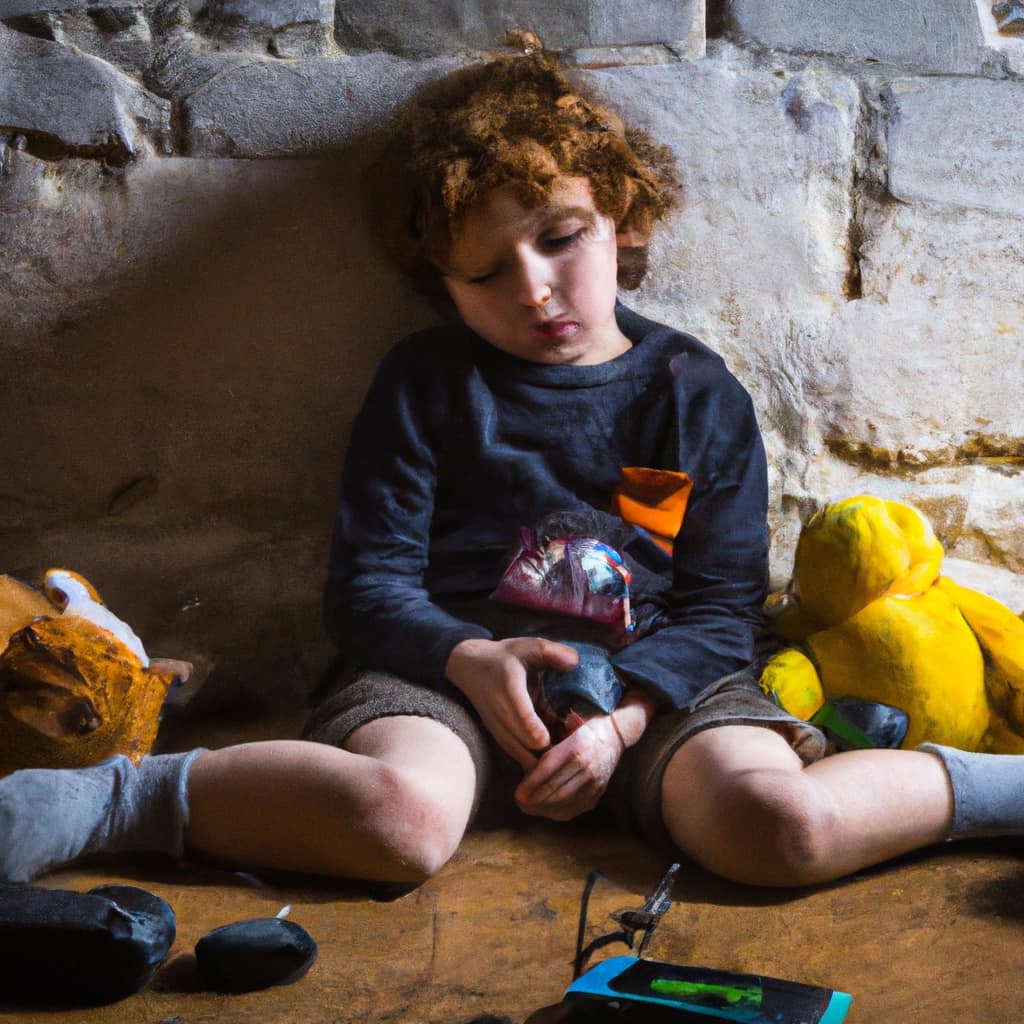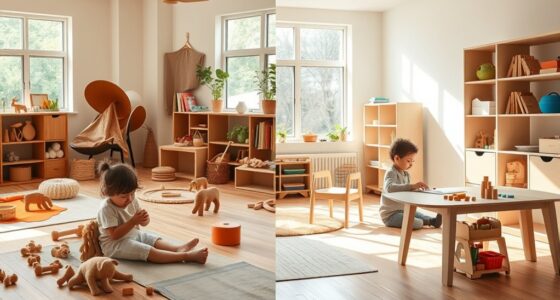In Waldorf play, you’ll notice a focus on hands-on, imaginative activities that foster emotional and artistic growth through natural materials like wood, wool, and silk. Montessori play centers on self-directed exploration with carefully curated, skill-specific materials designed to promote independence and focus. While Waldorf emphasizes sensory-rich, emotional experiences, Montessori encourages order, discipline, and problem-solving. To discover how these differing philosophies shape children’s play, keep exploring what sets them apart.
Key Takeaways
- Waldorf emphasizes imaginative, artistic play with natural materials to foster emotional and sensory development.
- Montessori encourages self-directed, practical play using curated materials that promote independence and problem-solving.
- Waldorf’s play is unstructured and story-driven, nurturing creativity and emotional connection.
- Montessori’s play involves structured activities that develop fine motor skills and cognitive skills.
- Both approaches aim to support child development but differ in their focus on emotional versus practical and independent play.

When choosing between Waldorf and Montessori education, understanding their fundamental differences can help you make an informed decision. These approaches each foster unique ways for children to explore and develop their skills, particularly through how they encourage artistic expression and shape the classroom environment. With Waldorf education, the classroom environment is intentionally warm, inviting, and designed to feel like a cozy, home-like space. The focus is on creating a nurturing atmosphere where children feel safe and inspired to express themselves freely. Artistic expression is central to Waldorf learning; children are encouraged to engage in painting, storytelling, music, and crafts that cultivate their imagination and emotional development. Instead of rigid worksheets or standardized tests, the environment promotes hands-on activities that allow children to explore their creativity in a relaxed, unhurried setting. Natural materials like wood, wool, and silk are prevalent, reinforcing the sensory-rich experience and fostering a sense of beauty and harmony. This immersive environment helps children connect with their work on a deeper level, emphasizing the aesthetic and emotional dimensions of learning.
In contrast, Montessori classrooms are designed with a focus on order, independence, and self-directed activity. The classroom environment is typically more structured, with carefully arranged shelves and materials that are accessible to children, allowing them to choose activities that match their interests and developmental stages. This setup promotes autonomy and responsibility, encouraging children to take ownership of their learning. Artistic expression in Montessori settings is integrated into everyday activities, but it often emphasizes fine motor skills and practical tasks, such as drawing, painting, or assembling materials. While creativity is valued, the approach tends to prioritize precision, concentration, and skill development through carefully curated materials that are designed to guide children step-by-step. The environment supports this by providing a calm, organized space that minimizes distractions, helping children focus and develop discipline alongside their artistic pursuits. Montessori’s emphasis on self-directed learning means children learn through exploration and manipulation of materials, fostering independence and problem-solving skills.
Ultimately, your choice depends on what kind of learning environment resonates most with your child’s personality and your educational goals. Waldorf nurtures artistic expression within a warm, sensory-rich environment that emphasizes emotional growth, while Montessori offers a more structured, self-directed approach that cultivates independence and practical skills. Both philosophies value play as a crucial part of childhood development but do so through different lenses—one through imagination and emotional connection, the other through order and autonomy. Understanding these core differences can help you select a setting where your child will thrive and explore their potential to the fullest.
Frequently Asked Questions
How Do Waldorf and Montessori Approaches Impact Emotional Development?
Your child’s emotional development benefits greatly from their play environment. A nurturing approach fosters emotional resilience, helping them manage feelings and adapt to challenges. It also builds social confidence, encouraging positive interactions and teamwork. When play is purposeful and supportive, your child learns to express emotions healthily and develop strong interpersonal skills, setting a foundation for well-rounded emotional growth.
Are Waldorf or Montessori Methods Better for Children With Special Needs?
You might wonder which method better supports children with special needs. Both approaches can be effective, but Waldorf’s emphasis on inclusive practices and sensory integration often makes it more adaptable for diverse learning needs. Montessori’s structured environment also promotes independence. Consider your child’s specific needs, and look for programs that prioritize inclusive practices and sensory integration, helping your child thrive in a supportive, tailored setting.
What Are the Teacher Qualifications for Waldorf and Montessori Schools?
Think of teacher qualifications as the roots that hold a sturdy tree. In Waldorf schools, teachers typically hold a Waldorf teaching certification and have a background in arts or humanities, emphasizing holistic growth. Montessori teachers usually possess specialized certification and training in Montessori methods, focusing on child-centered learning. Both schools prioritize well-trained educators, but certification standards guarantee your child’s teacher is equipped to nurture their development effectively.
How Do Play Materials Differ Between Waldorf and Montessori Classrooms?
You’ll notice that play materials in Waldorf classrooms mainly consist of natural materials and open-ended toys, encouraging imagination and sensory exploration. Montessori environments, on the other hand, feature carefully chosen, manipulative toys designed to promote independence and fine motor skills. Both approaches emphasize quality over quantity, but Waldorf focuses on natural, aesthetic items, while Montessori prioritizes educational, purpose-built tools to support specific learning objectives.
Can Children Switch Between Waldorf and Montessori Education Easily?
You might wonder if children can switch between Waldorf and Montessori education easily. While curriculum compatibility varies, a well-planned progression can help. You should focus on applying effective transition strategies, such as gradual introduction and familiarization with new routines. With patience and support, children adapt better, appreciating each approach’s strengths. Ultimately, understanding their unique needs and providing consistency eases the switch, making it a positive experience for your child.
Conclusion
Ultimately, choosing between Waldorf and Montessori is like selecting the path of a river or the branches of a tree—each leads to growth, discovery, and unique beauty. Both philosophies nurture your child’s potential, guiding them to blossom into their fullest selves. Trust your intuition to choose the one that resonates most with your values, knowing that, like a seed, your child’s future will flourish wherever love and thoughtful guidance are planted.











